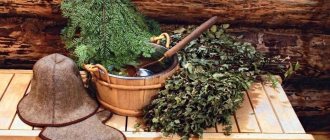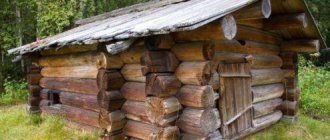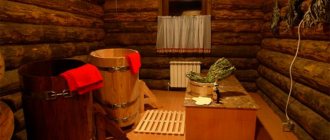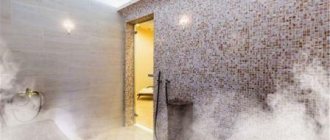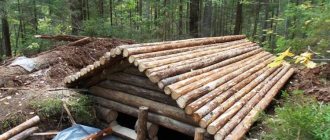With a sick person
Although the bathhouse is beneficial to health in many cases, there are a number of contraindications according to which visiting the bathhouse is not recommended. For example, people with cardiovascular diseases, certain respiratory tract ailments, and endocrine problems (at least in acute form) should not do this. Such a person may have an attack, and you will have to pump him out.
You should also refrain from going to the bathhouse together with people suffering from some kind of skin diseases or infections - you can easily become infected from such a person, especially if you use the same bath accessories.
With an unmarried woman
In the old days, men went to wash first, and only then women, as they were considered “unclean.” But in some regions there were other restrictions.
“In the Vladimir province, by the way, there is such a belief that it is not a sin to wash in the baths only for husband’s wives, but for widows and girls it is a sin: “but if with prayer, then they are forgiven,” says Maksimov in the book “Unclean, unknown and godly power." It is clear that unmarried people were not forbidden to wash in the bathhouse at all, but they were not allowed to go there with married women.
Black sauna: an excursion into history
The Russian bathhouse was first mentioned in documents of the 10th century. But some researchers argue that baths in Rus' have a much more ancient origin and date back to the 5th century. The main distinctive characteristics of the Russian bath are very high temperatures and the use of a broom, initially only birch. The first Russian baths were heated in black. In Rus', for a long time, the bathhouse was treated as a special place where the elements of water, fire, earth and air were present. Here they gave birth, treated, told fortunes, and washed the dead. It was mandatory to visit the bathhouse before the wedding. Guests were invited to the bathhouse.
Foreigners called washing in a Russian bathhouse voluntary torture. The British, when they first arrived in the Russian North, noted with bewilderment that Russian barbarian families washed themselves in smoky huts heated to unbearable heat, and whipped each other furiously with twigs.
Construction of a black sauna
In a low log structure, almost rooted into the ground, with a small window, and sometimes without it, a hearth was built from boulders and clay right at the entrance on the ground. It was lined with natural stones on all sides, stones were poured on top, and this is how the heater turned out.
The water was heated by placing hot stones in a tub. Behind the heater, a high shelf was attached to the wall for steaming - shelves, and benches were placed along the walls. The door to the steam room was very low, and the threshold, on the contrary, was high. Thus, the bathhouse was kept warm.
In winter, the earthen floor was covered with hay or straw, in summer - with freshly cut grass. Branches of bushes and trees, field herbs were placed on the heater, and when water was poured over the stones, a unique aroma spread in the bathhouse. Subsequently, the floor began to be covered with boards. The bathhouse had no chimney; smoke came out through the window, the front door and vents on the ceiling and walls. Soot and smoke settled on the logs, which over time became completely black. That's why the bathhouse was called black.
Not everyone could heat a sauna properly. Difficulties arose with the kindling. The firewood used for the bathhouse was well-dried, so it flared up instantly and immediately began to smoke. The smoke corroded the eyes and got into the nose, but this did not stop the Russian man at all.
In order not to get burned, it was necessary to light the wood and quickly jump out of the bathhouse. It was necessary to add firewood to the fireplace just as quickly. After heating, the coals were removed from the hearth, the shelves and benches were washed, the vents were closed and several ladles of water were poured onto the hot stones.
The bath was kept until the carbon monoxide completely disappeared. Only after this was it possible to take a steam bath.
With a stranger
“Despite the fact that “the bathhouse soars, the bathhouse is regulated, the bathhouse will fix everything,” since ancient times it has been recognized as an unclean place, and after midnight it is even considered dangerous and scary: not everyone dares to look there, and everyone is ready to expect some kind of trouble, which “some chance and unexpected meeting,” Maksimov frightens.
Not only that, a stranger met in the bathhouse or near it may turn out to be an attacker with bad intentions or a sorcerer (and the bathhouse in the old days was often used for various witchcraft rituals).
It could even be some otherworldly entity. So, if you believe the stories, sometimes unmarried girls performed a ritual on the “betrothed-mummer”, inviting him “to wash in the bathhouse.” As a result, the bannik himself appeared under the guise of his “betrothed.”
Krinichnaya in the book “Russian Mythology. The World of Folklore Images" talks about the popular belief according to which girls cursed by their mothers become bathhouse “brides” and are kept in the bathhouse in captivity by the bannik and Obderikha until a suitable groom appears: “She catches a guy who entered the bathhouse at night, at the moment when he wants to take a “pebble” from the heater, and, not without threat, offers himself as a wife. The outcome is usually predetermined: “I got married at Obderikha’s house.” Refusal is impossible: it threatens disaster.”
Russian bath. Notes and comments on construction and operation.
Besides him, almost half of the male part of the family was engaged in this craft. I’ll make a reservation right away that everything I write has to do with a simple village Russian bathhouse.
Most of all I have comments on the most respected in our country (and undeservedly forgotten almost everywhere) “black” bathhouse. The oldest one I saw was built by my great-grandfather, but I remember it quite well (it was demolished about twenty years ago).
So - comments:
“There are two types of Siberian bathhouses: with a black firebox, a simpler type in which the smoke, having passed through the heat accumulator stones, collects inside the bathhouse under the ceiling and comes out through a hole in the wall or ceiling.” There is also a third type: without any holes. The smoke escapes through the door perfectly. It also serves as a regulator. Although the door is also a hole.
“The walls of the black bathhouse warm up faster and stronger, since the heat from the firebox, having passed through the stones, does not fly out into the chimney, but spreads inside.”
In addition, in the “black” bathhouse there is a completely different “spirit”. It heats up more evenly. In winter, a white bathhouse often has a cool floor, although the ceiling is hot. This does not happen in black - the contrast is softer. You can freely supply steam while sitting on a shelf without the risk of getting burned - the steam from an open heater is softer. The steam is never “prickly” and does not “spread” in layers, but seems to “fall” from above.
“In a sauna, only the ceiling and the top of the walls are smoked black, because the smoke accumulates at the top.” Rather, they are “flying in the ointment.” The black color comes from tar. There is very little real soot (it does not settle on hot objects). Soot is a sign of a bad stoker. The black bath is generally more demanding of his art. It is necessary to stack the firewood so that it flares up very quickly and immediately gives off heat. Then there will be almost no soot and no smell of smoke.
“Saunas with a white firebox are common throughout our country. In it, the smoke from the heater is removed through a pipe, due to which the atmosphere in the steam room is not polluted, and there is no need to ventilate the steam room or wash the walls. Such a bathhouse is more hygienic and modern.”
As for “modern” - yes. As for “hygienic” - by no means. The atmosphere in the bathhouse becomes blackly polluted only by the incompetent, and so much so that you can get sick. A normally heated black sauna has no more polluted atmosphere. In addition, there will be no mold in it, even after a long period of inactivity - tar in the walls kills everything. Behind my house there are still several logs of the upper crowns from the old, great-grandfather’s bathhouse; from age and heat they have become brittle, but they practically do not rot to this day. In a black bathhouse, fungal diseases that can be transmitted in a city bathhouse never take root. In the old bathhouse there were hooks along the walls - clothes of sick people were hung on them for disinfection.
A few more words about the black bath.
Its advantages :
- higher quality spirit - more uniform heating - disinfecting effect - log house does not rot for a long time - heats up faster in winter
Disadvantages (which negated its popularity):
- requires more literacy during construction. Mistakes will have a significant impact later - it requires a certain skill of the stoker. He must be physically healthy, since it is difficult to walk on all fours (smoke above) several times into an already heated room. In addition, if incorrectly stacked firewood goes out, you will have to stack it again in a smoky room. The heating of a black bath cannot be entrusted to a teenager or an old man - you have to “sacrifice” your working hands. In addition, the stoker must be able to properly turn off the stove and ventilate and rinse the bathhouse - it is demanding on firewood. Do not use rotten or heavily smoking ones - the smell of smoke will remain - do not light the stove while washing. If a lot of people go to the bathhouse, you will have to heat it harder, and the first batches will be hot - it is darker in such a bathhouse - you will have to install stronger lamps - you cannot leave any objects in the upper half of the bathhouse
Now, comments in general about the Russian bath
“cobblestones, or better bricks, heat up, since cobblestones crack, their heat capacity is lower”
NOT TRUE! You just need to be able to pick up cobblestones. In my bathhouse, most of the stones were taken from the bathhouse built by my great-grandfather almost a hundred years ago. And they drowned her very often. Heated bricks should not be poured with water - they do not tolerate it well. Cobblestones crack very rarely and are usually harmless - they simply fall apart in two. They need to be inspected every few years. It’s difficult for me to describe the pattern, but the surface of a cobblestone that has “fallen into disrepair” becomes porous, with shells. If you “bale” it with something sharp, it crumbles, and the inside of such a stone is made of “grains” that are easily painted.
In an open heater, stones generally last longer, since the principle is the opposite of modern iron stoves - instead of a small number of almost red-hot stones, there are a large number of simply well-heated ones (usually about five buckets of cobblestones). I don’t remember my grandfather’s lessons very well now, but he told me in some detail how stones were chosen. In particular, you should not take cobblestones with a bluish-yellow tint - they “give off a caustic fume if they warm up.” In addition, the shape matters (the shape of a flattened egg is best). A good stone should make a "clanging" sound when it hits a hard surface. When laying stones, they are sorted by size: large ones go down (up to 30 cm in diameter), small ones go up (5-6 cm). Small stones are not afraid of contrast when poured with water (like thin-walled dishes), but large stones are already heated.
In the old days, the stove was made without bricks or iron parts at all - a semblance of an arch was simply laid out of cobblestones.
“It is better to use pine, spruce, and larch for walls, floors and ceilings. Coniferous wood gives off a special, pleasant and fresh aroma and absorbs a lot of heat.” Oh? I even sometimes go to a bathhouse that a city dweller built after reading a clever book. In addition to its pleasant aroma, pine produces a delicious resin, drops of which charmingly fall on the naked body. There is no need for extra aroma from the walls in the bathhouse - a broom and herbs will suffice. And for all wooden buildings associated with water, carpenters recommend aspen. Wells are most often made from it. It is better to refrain from conifers, at least on the ceiling. You can make lower crowns out of them. Besides, isn’t a log house made of spruce too expensive? You also can’t make a bathhouse out of oak or poplar - there will be a heavy spirit. Probably, in the description it should be emphasized that the pine, at least, should be of the “dry” variety, since anyone caught on a resinous pine will notice the mistake too late.
“A layer of expanded clay, dry earth, fallen leaves or dry peat is poured onto the ceiling for insulation.” The best thing is a mixture of equal amounts of clay and sawdust, leaves or straw.
“It is advisable to heat the bathhouse with dry birch firewood, which produces less soot, or aspen, pine, oak, spruce, etc.”
Birch trees produce no less soot; tar used to be extracted mainly from birch trees. Look at the flame of birch wood - it is redder. But they are very hot, that’s why they heat them.
“The good thing about a tiled floor is that it is easy to care for. A wooden floor gets trampled down quite quickly and it will no longer be possible to restore it to a “decent” condition in a year or two. It can only be replaced. But all this simply does not threaten the tiles - and the water drains well from it, and it is not difficult to clean.”
Nonsense. A good wooden floor lasts at least ten to fifteen years. The boards are laid with gaps of about 1-2 centimeters so that small debris does not clog them. Water escapes through the cracks. Sometimes the boards are not nailed down at all, and after washing they are turned on edge. the soil under the floor must be selected and the space filled with sand, into which water easily drains. The logs are placed on posts, so they also don’t rot too much. Larger gaps are left near the walls and the boards should not fit tightly to the wall. The tiled floor is slippery.
In addition, if a person does fall (especially a child), the tiled floor will “provide” a much more severe injury. The tiled floor will be either cold or hot.
“An open heater is preferable if several people are steaming on the same day, as it quickly heats up the steam room, but under the influence of water it quickly cools down.” In addition, it produces softer steam. But it doesn’t cool down any faster—you can put more stones in an open heater. And one more advantage - if a lot of water is mistakenly splashed into a “fading” stove, it will remain in an iron stove with a closed heater and, during the next heating, it will begin to produce steam when it is not needed at all. In an open heater it will simply go down.
“Due to the accumulation of heat by the masonry and stones, a stove with a closed heater creates a high temperature in the steam room not only during steaming, but also in the next one or two days. In a Russian bathhouse, a stove with a closed heater is usually installed.”
Let's draw a parallel. A hot iron will heat the room much more than a warm radiator. So? How warm the bathhouse will be depends on the quality of the walls and ceiling. Judge for yourself: the room has some thermal insulation. There is some heat reserve in the room. Any stove gives off heat to the air. Therefore, WITH a CORRECTLY folded stove, regardless of whether the heater is open or not, the heat will be retained equally. The only difference is short-term heating and cooling. All the heat created by wood will eventually escape through the door and walls with any stove and at the same rate. It is better to regulate heat accumulation not by the closed/open nature of the heater, but by the mass of stones. By the way, in a black sauna the heat does not escape through the chimney.
In a Russian bathhouse, a stove with a closed heater has usually been installed for the last seventy years; traditionally, the heater was open.
“Stoves for individual baths are made of brick or metal. They are simple and reliable, heat-intensive, and create a favorable atmosphere of healthy steam.”
Iron stoves hardly contribute to healthy air. They produce scale, a noticeable smell of burnt metal. Any debris that accidentally gets on them will smolder with a disgusting smell. They rust, when exposed to strong heat, they warp and require insulation from the walls. They are a source of danger - a hot iron object that can easily get burned. In my opinion, these ovens are for the lazy. They have practically no advantages other than ease of installation (bought - installed).
Anyone who can build a normal stove will not install a “potbelly stove”. It doesn’t matter whether in the bathhouse or in the house.
That's probably all. These are simply substantive comments based on facts and experience. In general, if something has existed without significant changes for several centuries - be it a bathhouse, a Chukchi tent, or a Japanese bamboo house - then it is something close to perfection. And people are building baths in the main masses more and more illiterately. I’ve already seen examples where the stove was located on the way from the shelf to the door - it’s impossible to do anything more stupid. Another craftsman not far from me, not more than a week ago, nailed logs of a log house to each other with huge nails. In short, either I don’t understand something, or people have begun to do many traditional things much more stupidly.
rusbani.narod.ru
By oneself
In the old days, they tried not to go to the bathhouse alone: they believed that a lonely person could easily become a victim of the bathhouse evil spirits. “Whoever boasts that he will bring a stone from the heater at midnight will inevitably face a test or severe punishment,” Krinichnaya reports. – After twelve o’clock, the “owner” kills the person washing with a stone or throws stones at the person who comes here late in the evening (they fly from the direction of the heater).
“As it’s been said, you can’t have one muscle in the battle, it will ruin you, that’s how it is. We have one smart lady who says: “I’ll go alone to the baina for the third shift, when I’m washed off.” And she went. And there is no hour, and there is no other. And they went after her, and she was driven under the floor into an awl, and the skin was hanging on the heater. She ripped off her hair.”
If we discard beliefs, then a steam room is stress for the body. What if you feel bad and there is no one around? It’s better to take bath procedures in company.





